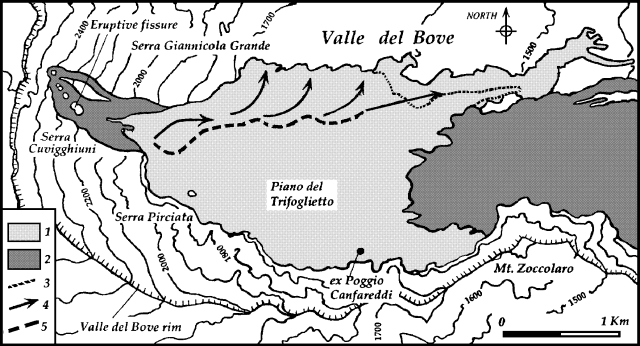Report on Etna (Italy) — March 1993
Bulletin of the Global Volcanism Network, vol. 18, no. 3 (March 1993)
Managing Editor: Edward Venzke.
Etna (Italy) 1991-93 eruption ends
Please cite this report as:
Global Volcanism Program, 1993. Report on Etna (Italy) (Venzke, E., ed.). Bulletin of the Global Volcanism Network, 18:3. Smithsonian Institution. https://doi.org/10.5479/si.GVP.BGVN199303-211060
Etna
Italy
37.748°N, 14.999°E; summit elev. 3357 m
All times are local (unless otherwise noted)
The following, based on the report of the IIV, describes activity in March.
The 1991-93 eruption ended on March 30 after 473 days of continuous lava flows. Lava stopped flowing to the S side of the flow field in mid-February, but continued to flow from several vents at 1,700-1,650 m elevation on the N side of the field, covering previous flows from the current eruption. Shortly after 8 March, an overflight revealed a thin flow that had traveled 0.5 km from an ephemeral vent at 2,020 m elevation. On 11 March a large lava flow moved toward the Valle del Bove over an area not yet covered during this eruption. Flowing 1.5 km from a large ephemeral vent at the end of a tube at 1,550 m elevation, lava spread down some gullies, stopping after 3 days at 1,390 m elevation, 5 km from the eruptive fissure (figure 59).
Lava flows declined in the second half of March. On 21 March a vigorous flow emerged from a vent at 1,850 m elevation and traveled several hundred meters NE in a few hours before slowing and finally stopping within two days. The remaining ephemeral vents gradually disappeared and the last small lava flow was observed on the morning of 30 March. In the following days, fieldwork at the eruptive fissure and along the upper lava tube revealed that no molten lava remained in the tube and that the delivery system was cooling.
Steady degassing continued through March at the summit craters. The floor of Northeast crater dropped another several meters. Seismicity remained low, especially from 1-10 March. For the month, 65 long-period events and 8 volcano-tectonic events (maximum M 2.4) were recorded. The only notable swarm occurred on 28 March when 10 events were recorded in two minutes. There were no significant variations in the volcanic tremor amplitude. Four of the 9 bore-hole tiltmeters recorded a sharp deformation event of moderate amplitude at the beginning of March.
The 1991-93 eruption began on 15 December 1991 and lasted 473 days. It was probably the largest eruption at Etna in the last 300 years, covering ~ 7 km2 with >250 million m3 of lava.
The following information compiled by volcanologists at the IIV, Univ di Catania, and OV complements the official IIV report above.
The lava flow that had reached 1,400 m elevation on 14 March (18:02) stopped on 17 March. At about 1700 on 21 March a modest lava flow escaped through a skylight on the main lava tube just below 2,000 m elevation. It was accompanied by intense degassing from the upper part of the eruptive fissure. Through 25 March lava was observed flowing inside the main vent at 2,205 m and small, short-lived flows issued from ephemeral vents in the N part of the lava field at ~ 1,900 m elevation. Poor weather prevented detailed observation of the last days of the eruption.
Degassing (vapor and gas) from the upper part of the eruptive fissure declined. By 20 March it was difficult to observe from a distance. Degassing increased at the summit craters (especially from the central crater) during the final phase of the eruption. Through 9 April, the NE crater, where recent rockfalls had occurred, continued to be obstructed and weak fumarolic activity was present along the walls. COSPEC measurements of SO2 flux revealed a sharp increase during the last half of March (>16 x 103 t/d on 23 March). Measurements in April indicated the flux was returning to a normal level of 6-8 x 103 t/d.
From 16 March to 19 April, 337 seismic events were recorded. They ranged from M 1.0-3.0 and showed characteristic frequencies of 1-6 Hz. All were located in the summit crater region except a M 2.7 at 0649 on 14 April that was located low on the E flank. Volcanic tremor was totally absent.
During the 1991-93 eruption an estimated 300 x 106 m3 of lava flowed from the fissure on the W wall of Valle del Bove at an average rate of 7.3 m3/s.
Geological Summary. Mount Etna, towering above Catania on the island of Sicily, has one of the world's longest documented records of volcanism, dating back to 1500 BCE. Historical lava flows of basaltic composition cover much of the surface of this massive volcano, whose edifice is the highest and most voluminous in Italy. The Mongibello stratovolcano, truncated by several small calderas, was constructed during the late Pleistocene and Holocene over an older shield volcano. The most prominent morphological feature of Etna is the Valle del Bove, a 5 x 10 km caldera open to the east. Two styles of eruptive activity typically occur, sometimes simultaneously. Persistent explosive eruptions, sometimes with minor lava emissions, take place from one or more summit craters. Flank vents, typically with higher effusion rates, are less frequently active and originate from fissures that open progressively downward from near the summit (usually accompanied by Strombolian eruptions at the upper end). Cinder cones are commonly constructed over the vents of lower-flank lava flows. Lava flows extend to the foot of the volcano on all sides and have reached the sea over a broad area on the SE flank.
Information Contacts: The first section is from the official report of theIIV. The second section is fromR. Romano, T. Caltabiano, M. Grasso, and M. Porto, IIV; P. Carveni and C. Monaco, Univ di Catania; G. Luongo, OV.


